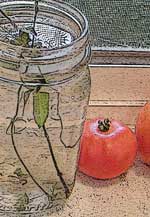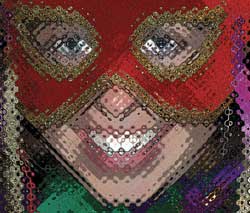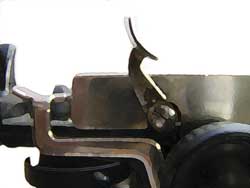Artist of the Month - September 2007 Blurring
the Lines with Craig Hibberd |
||||
Where
most artists might feel put off by the question “What
is it?” in response to their work, Craig Hibberd takes
it as a solid compliment. Well, he should. His images catch
the eye, but play with the mind.
He has brought together the skills honed through his background
in photography, graphic design and architecture to create this
new style of illustration. Although he has studied and taught
photography, he often felt that the originals showed flat colors
and depended too heavily on creating or waiting on the right
conditions, particularly lighting. Instead, he has found a
method of improving on reality through a unique form of digital
manipulation. For example, he recently
photographed the annual Mardi Gras parade put on by Wabi
Sabi, a local non-profit thriftstore, whose board he headed
for several years. The models wore elaborate fanciful costumes,
and while documenting the show, Hibberd availed himself of
the opportunity of photographing intriguing subjects. He
explains that “the subject
matter was spectacular, but the lighting, backgrounds and
technical quality was lacking.”
In “Alien’s Mandy”, he retained the image of the head and headdress and placed it on an extended black background, which accentuates the subject. He whitened the face and used warm, lively colors for the pompoms and tassels of the headdress, all of which appear to pop off the page. Shadows and texture are created through a mix of tinting and pointillism, which attributes to the illusion that this picture is not a photograph. What makes this image so particularly intriguing, however, is that all reference points have been eliminated, leaving the viewer to ponder the image, a mischievously merry head floating tethered only to an enormous headpiece that could be culturally historical or simply fanciful. Although Hibberd’s
work is not entirely abstract, that element surfaces in most
of his images, particularly the more recent ones. He uses
various digital filters to create his art, which aid him
in depicting realism through the filter of his perspective.
Hibberd enjoys a wide range of subjects for his images, including
still lifes, people and machinery. His understanding of how
different materials reflect light honed during his study of
black-and-white photography emerges in images he has created
by abstracting parts of a car engine and a typewriter. A particular
favorite of mine is one in which the image is distorted enough
that recognizing the return carriage of a typewriter is difficult.
Not only does the image create interesting patterns using rich
browns and grays, but it also makes a statement about the mechanical
nature of writing. |



